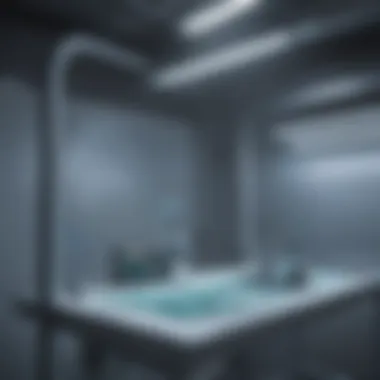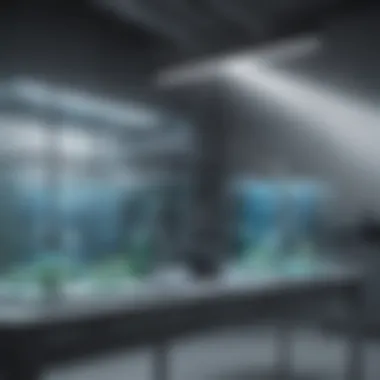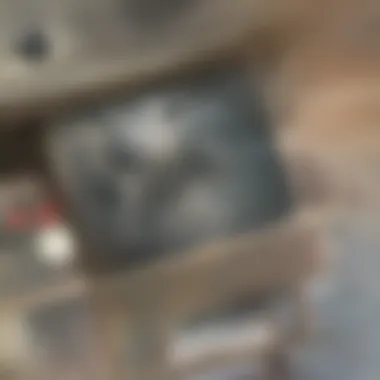The Impact of 222nm UVC Lamps on Modern Disinfection


Intro
As modern society increasingly grapples with the spread of infectious diseases, the search for effective disinfection technologies has gained immense momentum. Among these innovations, 222nm UVC lamps have emerged as a prominent solution, known for their germicidal properties. This article aims to provide a thorough exploration of how these lamps function, their applications, safety considerations, and the ongoing research highlighting their effectiveness.
The importance of disinfection in healthcare and public spaces cannot be overstated. Traditional methods often involve harsh chemicals or prolonged exposure to specific light wavelengths. In contrast, 222nm UVC lamps present a promising alternative by harnessing a specific range of ultraviolet light that efficiently inactivates pathogens without causing harm to human skin or eyes. This nuanced approach to disinfection is not only about efficiency but also prioritizes safety and practicality.
By dissecting the scientific principles, practical applications, and regulatory issues surrounding 222nm UVC technology, this article serves to inform educators, researchers, and practitioners about a transformative advancement in sanitation standards.
Preface to 222nm UVC Lamps
The introduction of 222nm UVC lamps marks a significant advancement in the field of disinfection technology. This section explores the fundamentals of UVC light and its relevance in today's hygiene-focused world. With increasing concerns about infectious diseases and a heightened emphasis on cleanliness, understanding the operational mechanisms and applications of 222nm UVC lamps becomes essential.
In regard to disinfection, 222nm UVC lamps are especially valuable as they provide an effective method to eliminate pathogens without leaving harmful residues. The potential for these lamps to be integrated into various environments—such as healthcare facilities and public spaces—highlights their versatility. They not only enhance safety but also improve the overall efficiency of sanitation practices.
Defining UVC Light
Ultraviolet (UV) light is a form of electromagnetic radiation with wavelengths shorter than visible light. It is categorized into three types: UVA, UVB, and UVC. UVC light, specifically, ranges from 100 to 280 nanometers, with 222nm being notably effective for disinfection. This particular wavelength has garnered interest because its germicidal properties are linked to its ability to disrupt the DNA of microorganisms.
The Spectrum of Ultraviolet Light
The ultraviolet spectrum encompasses a range from approximately 10nm to 400nm. While UVA and UVB are more commonly known for their roles in skin damage and sunburn, UVC plays a critical role in sanitation. UVC light is absorbed by DNA and RNA, which can lead to cellular death or replication failure. This is particularly important for controlling microbial populations in various settings. The specific range of 222nm falls within the UVC category and is crucial for effective germicidal action without causing harm to human skin and eyes.
Characteristics of 222nm UVC
222nm UVC light exhibits unique properties that differentiate it from other forms of UV light. One of its key characteristics is that it is effective against a broad spectrum of pathogens, including bacteria, viruses, and fungi. Additionally, its ability to inactivate pathogens without significantly damaging living tissues is a substantial advantage in its application.
Moreover, research indicates that 222nm UVC is less harmful to human skin and eyes compared to conventional UVC wavelengths. This has opened new possibilities for its use in occupied spaces, allowing for disinfection without requiring evacuation or extensive safety precautions. The implications of these characteristics are vast, suggesting a transformative potential in public health practices and environmental safety.
Mechanisms of Action
Understanding the mechanisms by which 222nm UVC lamps operate is crucial. This knowledge underpins their effectiveness in modern disinfection practices. The specific ways in which UVC light interacts with microorganisms clarify its utility in various settings.
How UVC Kills Microorganisms
UVC light, particularly at 222 nanometers, kills microorganisms primarily through DNA disruption. When exposed to UVC light, the DNA within bacteria and viruses absorbs the energy, leading to the formation of pyrimidine dimers. These dimers distort the DNA structure, preventing the organism from replicating or performing essential cellular functions. This process is rapid and effective, making UVC a strong candidate in the battle against pathogens.
Laboratory studies have shown that 222nm UVC can inactivate a broad range of microorganisms. It is noteworthy because different pathogens display varying levels of susceptibility to UVC. Most notably, common bacteria like Escherichia coli and viruses such as the influenza virus are significantly affected.
DNA Damage and Repair Processes
The DNA damage caused by 222nm UVC is significant. When exposed, microorganisms attempt to repair their DNA. However, repair mechanisms can be inadequate or fail entirely when the damage is extensive. For example, organisms utilize the nucleotide excision repair system, which processes the lesions. Although some bacteria have sophisticated repair systems, the efficiency can greatly reduce in the presence of repeated UVC exposure.
One important aspect is that while the damage can sometimes be repaired, it requires energy and resources that the organism may not effectively mobilize during stress conditions or environmental extremes. Over time, consistent exposure to UVC can overwhelm these repair processes, prompting inevitable cell death.
The potency of UVC in damaging DNA means it can serve not just as a disinfectant but as a potential method in addressing microbial resistance by hampering their repair mechanisms.
Interaction with Various Pathogens
Different pathogens react to 222nm UVC light in distinct manners. Bacterial spores exhibit a higher resistance to UVC compared to vegetative cells. However, many viruses, which lack cellular structures, are highly susceptible due to their RNA or DNA composition. This varying susceptibility underscores the importance of understanding the unique interactions involved.


While certain pathogens may display resistance, recent research has found that 222nm UVC can effectively target and reduce their populations significantly. It is essential to note that environmental factors like surface type and any protective biofilm can impact UVC efficacy.
Moreover, various environmental conditions can affect how effectively UVC light penetrates and inactivates different types of microorganisms. For instance, surface texture and shadowing can create barriers that inhibit light exposure, leading to areas of reduced efficacy during disinfection processes.
In summary, the mechanisms of action highlight not only how effective 222nm UVC lamps can be but also reveal aspects that need further exploration to enhance their application against resistant strains of pathogens.
Applications of 222nm UVC Lamps
The deployment of 222nm UVC lamps across various sectors is increasingly relevant in the discourse on modern disinfection. These lamps provide a unique solution that aligns well with the growing demand for effective sanitation methods. Notably, their applications span healthcare settings, public environments, and integration in air and water purification systems. Each of these domains showcases the capabilities of 222nm UVC technology by addressing different sterilization needs while also considering safety and efficiency.
Healthcare Settings
In healthcare environments, maintaining a sterile atmosphere is essential for patient safety and infection control. The use of 222nm UVC lamps in hospitals and clinics has gained traction due to their effectiveness in eliminating pathogens without producing harmful ozone. These lamps target a range of microorganisms, including bacteria, viruses, and fungi, thereby reducing hospital-acquired infections. Operating rooms, patient rooms, and waiting areas can benefit significantly from this technology.
The integration of 222nm UVC in healthcare not only enhances cleanliness but also fosters a sense of security among patients and staff alike.
Moreover, these lamps can be used alongside traditional cleaning methods to achieve a more comprehensive disinfection routine. Important to note, specific protocols must be established to maximize their efficacy while ensuring safety.
Public Environments
Public spaces such as schools, offices, and transportation systems are under constant scrutiny regarding hygiene. Deploying 222nm UVC lamps in these settings can reduce the transmission of pathogens effectively. They can be incorporated in air ducts and used for surface disinfection, thus addressing the multifaceted nature of public health challenges.
In high-traffic areas, the rapid operation of these lamps can lead to significant reductions in bacterial load. Additionally, they provide a cost-effective alternative to chemical disinfectants, which might pose health risks or lead to resistance over time. Monitoring and adjusting the placement and duration of exposure to the UVC light are crucial elements to consider ensuring optimal results.
Incorporation in Air and Water Purification
The application of 222nm UVC technology extends into air and water purification systems. In air treatment systems, these lamps can effectively eliminate airborne pathogens, contributing to better indoor air quality. This application is particularly relevant for facilities such as gyms, offices, and commercial buildings, where ventilation and air quality are paramount.
When applied to water purification, 222nm UVC lamps can eradicate harmful microorganisms without introducing chemicals to the water supply. This usage is significant in both residential and municipal water treatment systems. The specificity of the UVC wavelength enhances its effectiveness in deactivating pathogens, making it a preferred choice for ensuring water safety.
Advantages over Traditional Disinfection Methods
The use of 222nm UVC lamps in disinfection presents several distinct advantages compared to traditional methods. These advantages span efficiency, safety, and resource use, making 222nm UVC a compelling alternative in diverse settings. By focusing on these key elements, we gain a comprehensive understanding of why this technology is attracting significant interest.
Speed and Efficiency
222nm UVC lamps operate at an impressive rate, offering rapid disinfection capabilities. Unlike conventional chemical methods, which may require extended contact times, UVC lamps can inactivate a wide range of pathogens in mere seconds. This speed is critical in environments such as hospitals, where every moment counts in preventing the spread of infections.
The efficiency of 222nm UVC is due to its ability to exert a germicidal effect without the need for prolonged exposure. Studies have shown that it can eliminate 99.9% of harmful microbes, including viruses, bacteria, and fungi, within seconds of exposure. The increased effectiveness in a shorter time frame not only reduces wait times but also enhances throughput in facilities requiring constant sanitation.
Enhanced Safety Profiles
Safety is a paramount consideration in disinfection practices. One of the noteworthy advantages of 222nm UVC is its reduced risk to human health compared to traditional UV sources. Traditional UVC disinfection involves wavelengths that can cause harm to skin and eyes. In contrast, 222nm UVC has been shown to be safe for unprotected human exposure while still effectively killing pathogens.
This safety characteristic opens countless possibilities for its application in occupied spaces, such as schools, offices, and public transit. Thus, the deployment of 222nm UVC helps maintain hygienic environments with less concern for adverse effects on human health. This attribute is particularly relevant in today’s context, where organizations prioritize both cleanliness and worker safety.
Reduced Chemical Usage
The transition towards 222nm UVC disinfection aligns with the growing need for environmentally friendly practices. Traditional disinfection methods often rely on chemical agents that may have harmful side effects, create waste, and contribute to indoor air pollution. In contrast, 222nm UVC disinfection operates without the need for such chemicals, minimizing the ecological footprint.
By utilizing light as a disinfection mechanism, organizations can reduce their dependency on chemical substances, thus decreasing the overall risk of chemical exposure to workers and the public. Furthermore, this method also reduces the need for extensive waste disposal processes associated with chemical treatments, contributing to a more sustainable approach in maintaining hygiene standards.


"Switching to 222nm UVC disinfection can significantly enhance operational efficiency, safety, and sustainability across various platforms."
In summary, the advantages offered by 222nm UVC lamps over traditional disinfection methods demonstrate a significant leap forward. The speed and efficiency of disinfection, coupled with an enhanced safety profile and a reduction in chemical use, place 222nm UVC in a prominent position as a leading technology in the field of disinfection. These factors not only enhance public health and safety but also resonate with the global movement toward more eco-friendly practices.
Potential Drawbacks and Limitations
The implementation of 222nm UVC lamps, while promising, is shadowed by several potential drawbacks and limitations. Understanding these drawbacks is crucial for a balanced perspective on the technology. It is essential to recognize both the benefits and the limitations when discussing any advanced disinfection method. This approach ensures responsible and informed use, promoting better health outcomes.
Health Concerns
Skin and Eye Exposure
One prominent concern surrounding the use of 222nm UVC lamps is the risk of skin and eye exposure. Unlike traditional UVC light, 222nm is touted as safer for human tissues. However, this does not eliminate risks entirely. Skin exposure can lead to irritation and potential long-term effects not yet fully understood. Additionally, eye exposure can result in uncomfortable symptoms such as tearing, redness, and vision disturbances. Understanding these risks is pivotal for safe implementation in public and private settings.
"Awareness of the potential hazards associated with UVC exposure is critical for both users and those in the vicinity of disinfection processes."
Thus, protective measures must be in place when utilizing these lamps. Shields or barriers can help minimize exposure to unintended targets. Educating users about these health concerns can promote better compliance with safety protocols, enhancing overall effectiveness of disinfection efforts.
Material Compatibility
Another issue is the compatibility of 222nm UVC light with various materials. While this form of disinfection shows effectiveness against many microorganisms, certain materials might degrade when exposed over time. Plastics and rubber can become brittle or lose structural integrity under prolonged UVC exposure. This limitation is vital for industries relying on materials sensitive to light, as replacement costs can accumulate significantly. Manufacturers need to assess material compatibility to prevent unexpected damage.
Ineffectiveness Against Certain Pathogens
Lastly, the effectiveness of 222nm UVC lamps does not extend universally to all pathogens. Some viruses and bacteria exhibit resistance to UVC light, making them less susceptible to disinfection efforts. This limitation can undermine the overall efficacy of using 222nm UVC lamps, particularly in high-stakes environments like hospitals where every pathogen counts. Therefore, supplementary disinfection methods might be necessary to address these resistant strains, ensuring comprehensive sanitation.
In summary, while the advantages of 222nm UVC lamps are substantial, careful consideration of these drawbacks and limitations is equally important. Furthermore, ongoing research and development will hopefully mitigate these concerns in the future, refining the applications of this technology to enhance safety and effectiveness. The dialogue around potential health risks, material degradation, and the spectrum of pathogen susceptibility must continue as this technology develops.
Research and Development
Research and development (R&D) plays a critical role in advancing technology, particularly in the realm of disinfection. As health concerns increase with the emergence of resistant pathogens and global health crises, the exploration of effective disinfection methods is urgent. The integration of 222nm UVC lamps into modern disinfection measures exemplifies how R&D can create solutions that address these needs.
Current Scientific Studies
Ongoing scientific research evaluates the efficacy of 222nm UVC lamps across various applications. Studies have demonstrated that 222nm UVC light can inactivate viruses and bacteria without significant harm to human skin and eyes, making it a promising alternative to traditional disinfection methods. For instance, recent experiments show that this wavelength can reduce the viral load of pathogens like SARS-CoV-2 effectively.
Researchers are also investigating optimal exposure times and distances, which can vary based on the environmental context and pathogen type. Results from these studies inform practical applications in healthcare, schools, and public spaces, guiding how and where these technologies can be used safely.
"The efficacy of 222nm UVC technology could redefine sanitation standards in various industries," notes a leading researcher in the field.
This research is crucial in understanding not just the science behind 222nm UVC, but also its real-world implications. Additionally, peer-reviewed publications and findings can drive further investment and interest in the development of safer, more efficient disinfection technologies.
Emerging Technologies
Emerging technologies related to 222nm UVC lamps include advancements in design and efficiency. Innovations in bulb production and the miniaturization of devices mean that 222nm UVC can be integrated into existing infrastructures easily. Recent developments include portable devices that can be used in home settings, thereby extending its reach beyond institutional use.
Moreover, the application of smart technology, such as IoT-enabled UVC devices, enhances monitoring capabilities, allowing users to track exposure levels and optimize usage. These devices can adjust their operation based on real-time environmental data, which further ensures that disinfection is both effective and safe.
In the coming years, we may also see collaborations between manufacturers and researchers, aiming to bolster the efficiency of lamp output and reduce energy consumption. Such efforts are essential for promoting widespread adoption and acceptance of 222nm UVC technology.
By focusing on continuous research and development, the field of disinfection stands to evolve significantly. This not only addresses immediate health concerns but also supports future public health goals.


Regulatory Perspectives
Regulatory perspectives on 222nm UVC lamps are integral to their deployment in various settings. With the rise in UVC technology applications, especially in disinfection, understanding the legal and safety guidelines becomes critical. Effective regulation ensures that these devices meet certain standards, ultimately protecting public health and promoting safer deployment in crucial environments, such as healthcare facilities and public spaces.
Standards for UVC Devices
Standards for UVC devices play a crucial role in ensuring that these technologies effectively and safely eliminate pathogens. Organizations such as the International Electrotechnical Commission (IEC) and the American National Standards Institute (ANSI) are vital in establishing these benchmarks. Key elements include:
- Performance Metrics: Standards dictate the performance criteria that UVC devices must meet, including efficacy rates for disinfection and consistent UV output.
- Safety Guidelines: Standards also set forth measures to minimize harmful exposure, guiding manufacturers on acceptable levels of UV radiation.
- Quality Control: Regular inspections and certifications ensure manufacturers comply with established norms, helping to sustain quality control throughout the lifecycle of the product.
These standards benefit stakeholders by fostering trust and reliability in the technology.
Guidelines for Safe Usage
The guidelines for safe usage of 222nm UVC lamps are crucial for promoting responsible operations. These guidelines encompass several facets:
- Exposure Limits: Guidelines typically include recommendations regarding the duration and intensity of exposure to limit risks associated with UV radiation.
- Protective Measures: Recommendations often stress the use of personal protective equipment, such as goggles or protective clothing, to safeguard individuals in environments where UVC devices are employed.
- Operational Protocols: Institutions using UVC technology must develop clear operational protocols, including training staff on safe handling and application.
Safe usage guidelines are essential to balance the efficacy of disinfection and the safety of individuals.
Adhering to these guidelines not only protects users but also enhances the credibility of UVC technology within the community.
Future Outlook
The future outlook for 222nm UVC lamps is a critical component in understanding their role in modern disinfection practices. As society grapples with emerging health threats and increases in sanitation requirements, the integration of advanced technologies is essential. This section explores the anticipated advancements in technology, their implications for health and hygiene, and how these lamps might become an integral part of everyday life.
Predicted Technological Advances
Predictions around the technological evolution of 222nm UVC lamps are optimistic. Research and development are focusing on several key areas.
- Enhanced Efficiency: Future models of these lamps are expected to deliver greater energy efficiency. This will help in minimizing operational costs while maximizing the output of disinfecting power.
- Improved Design: Innovations in design could lead to more compact and portable UVC lamps that are easier to use in various environments.
- Smart Features: Incorporation of smart sensors might become standard, allowing devices to automatically adjust intensity and duration based on the pathogen load present in an environment.
- Multi-functionality: Future lamps may be designed not only for surface disinfection but also for air and water treatments, utilizing the same technology across multiple applications.
"Future advances in UVC technology hold the promise of innovative solutions to emerging disinfection challenges."
Integration in Everyday Use
The integration of 222nm UVC lamps into everyday use presents numerous benefits. In residential settings, there's potential for these lamps to become commonplace in maintaining hygiene. Here are some areas where integration may occur:
- Home Sanitization Devices: Small UVC devices could be used to disinfect home surfaces or even personal items like phones and keys regularly.
- Commercial and Public Spaces: The use of these lamps in public restrooms, schools, and offices could help continuously reduce microbial load in high-traffic areas, thus improving public health.
- Healthcare Facilities: Hospitals are likely to adopt 222nm UVC technology more broadly for sanitizing surfaces and air, especially in critical areas like operating rooms.
The End
The importance of the conclusion in this article lies in its ability to distill the vast information presented into clear and actionable insights. The role of 222nm UVC lamps in modern disinfection cannot be overstated. They represent a significant advancement in efforts to achieve hygienic environments, especially in hospitals, schools, and other public spaces. These lamps effectively target pathogens without the use of harmful chemicals, making them a preferable choice in many scenarios.
Summary of Key Findings
The key findings of this article highlight several important aspects:
- Efficacy: 222nm UVC lamps effectively disinfect surfaces and air, eliminating various pathogens, including bacteria and viruses.
- Safety: When used properly, these lamps have a minimal risk to human health compared to traditional UVC light. Their specific wavelength is less harmful to skin and eyes.
- Innovation: Ongoing research showcases new technologies and methods for enhancing UVC disinfection, which promises to improve its application in everyday scenarios.
These points collectively convey the advancements in disinfection technology, emphasizing the relevance of 222nm UVC lamps in contemporary sanitation efforts.
Final Thoughts on UVC Technology
As we look toward the future, 222nm UVC technology stands as a promising solution to persistent public health challenges. Ongoing studies and technological improvements will likely enhance its efficacy and safety, making it a staple in disinfection protocols. Understanding and integrating such technologies into regular practices can significantly improve hygiene standards across different sectors.
In summary, embracing 222nm UVC lamps potentially transforms how we approach sanitation, demonstrating their critical role in ensuring healthier environments.















